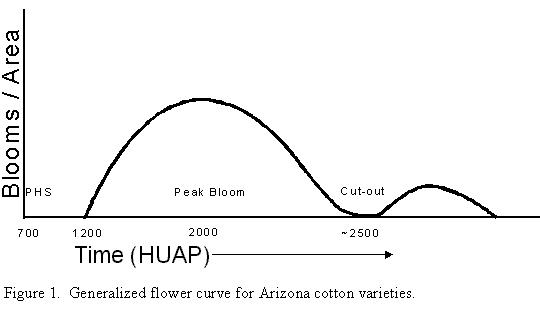Following Cotton Development Over the Fruiting Cycle
(Publication az1206)
(PDF file version, 33KB)
by Jeffrey C. Silvertooth,
Extension Agronomist - Cotton
As we follow the basic stages in the development of the cotton crop, we commonly look for points relative to the fruiting or flowering cycle (Figure 1). For example, early bloom, peak bloom, and cut-out are major stages in cotton crop development. We also generally recognize that the period between first bloom and cut-out is when the greatest potential in the crop yield is either gained or lost. In following the various stages from early bloom to cut-out, one could go through the process of counting fresh flowers in a given area on a regular basis, and then plot them over time during the course of the season. However, this represents a rather time consuming process, and what is more commonly done is a more general description of the crop that is often related to calendar dates.
In monitoring various plant growth factors, we have found that the Upland and Pima cotton varieties grown in Arizona can be tracked over their fruiting cycle by the use of several simple measures. The information presented in Table 1 outlines several approaches that can be used to track important stages in crop development such as first pinhead squares (PHS), matchhead squares (MHS), first bloom (FB), early bloom (EB), peak bloom (PB), and cut-out. These stages are outlined in terms of heat units accumulated since planting (HUAP), number of mainstem nodes present, and the number of nodes above the top white bloom (NAWB); which is also sometimes referred to as nodes above the top white flower (NAWF). The node numbers listed for various stages of growth and HUAP, represent minimum numbers of mainstem nodes that one should find at those points in the season.
If we examine a cotton plant and locate its top fresh bloom on a fruiting branch (at the first fruiting position from the mainstem), we can simply count the number of mainstem nodes above this top white bloom (NAWB) to the terminal (last node with a one inch diameter leaf) for an estimate of progression towards cut-out. Sampling several plants in this manner allows us to develop an average number for the NAWB. What is generally found for all Upland and Pima varieties is that the NAWB is representative of crop development as shown in Table 1. For example, at early bloom we would expect to find about 9 to 11 NAWB, and about 7 to 8 at or near peak bloom. Also, as the NAWB value decreases to 5 or less, the crop is progressing into cut-out. Distinct or complete cut-out has occurred when the plant has exhausted all existing fruiting sites, and blooms move to the top of the plant.
Cotton varieties will vary to some extent as to when or how fast they progress toward cut-out. The general ranges in expected cut-out for the three basic variety types is shown in Table 2 as a function of heat units accumulated after planting (HUAP, 86/55EF thresholds). Cotton growers can therefore monitor crop development over the season by simply counting the NAWB and compare that progression for the variety in question to the information listed in Tables 1 and 2. Estimates in HUAP can be easily obtained through AZMET or the UA weekly cotton advisory on a county basis. Tracking the crop in this manner offers a relatively easy method for watching for pre-mature or delayed progression through the fruiting cycle.
Issued in furtherance of Cooperative Extension work, acts of May 8 and June 30, 1914, in cooperation with the U.S. Department of Agriculture, James A. Christenson, Director Cooperative Extension, College of Agriculture and Life Sciences, The University of Arizona.
The University of Arizona is an equal opportunity, affirmative action institution. The University does not discriminate on the basis of race, color, religion, sex, national origin, age, disability, veteran status, or sexual orientation in its programs and activities.
Any products, services, or organizations that are
mentioned, shown, or indirectly implied in this web document do not imply
endorsement by The University of Arizona.
Information provided by Jeffrey C. Silvertooth, silver@ag.arizona.edu
Extension Agronomist - Cotton, College of Agriculture, The University of Arizona.
Material written February 2001.
Crop Mgmt | Soil Mgmt | Irrigation | Varieties | Cotton Comments
Home | Cotton | Advisories
document located at: http://cals.arizona.edu/crops/cotton/cropmgt/fruiting_cycle.html
Copyright © 2001 University of Arizona,
College of Agriculture and Life Sciences
Webmaster: Al Fournier (acis@ag.arizona.edu)


